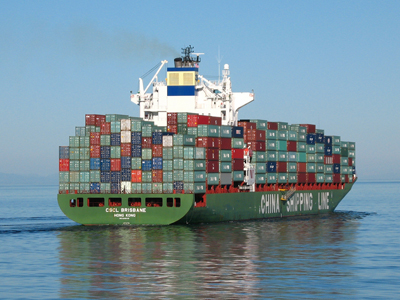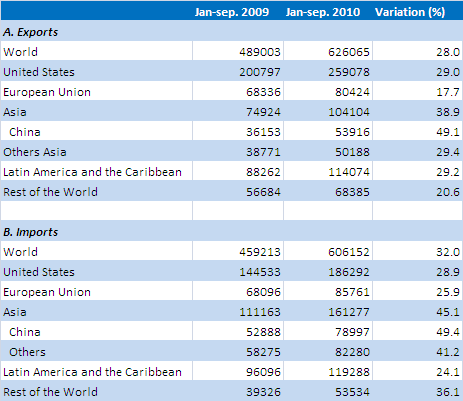Exports from Latin America and the Caribbean
to Asia-Pacific Show Strong Growth in 2010

Photo: Fusionopanda, Flickr
Latin American and Caribbean exports to Asia grew by 39% in the first three quarters of 2010, compared with the year-earlier period, thereby surpassing pre-crisis levels. This recovery was much more buoyant that total exports (28%) and exports to all other destinations. Meanwhile, imports from Asia expanded by 45%, compared with the figure of 32% for the region’s total imports.
In both cases, the result is strongly impacted by the even more buoyant trade with China, as this latter country’s exports and imports with the region grew by almost 50% between January and September 2009 and the same period of 2010 (see table).
Asia-Pacific and Latin America and the Caribbean are the two world regions with the highest economic growth, respectively, following their recovery from the global crisis of 2008-2009. As a result of this strong performance, in 2010 Asia consolidated its position as an increasingly importing trading partner for Latin America.
However, the region still faces the challenge of transitioning from what is mainly inter-industry trade (exporting raw materials and importing manufactures) towards increased involvement in the buoyant Asian value chains.
This requires regional exports to have more value added and knowledge, including exports of natural resources and services.
According to ECLAC, the situation bodes well for a strengthening of economic ties between Latin America and the Caribbean and Asia-Pacific, thanks to the post-crisis buoyancy of both regions.
Latin America and the Caribbean also has much to offer Asia, above and beyond raw materials. Following the crisis, the region has returned to the path of economic growth, poverty reduction and lowering unemployment that characterized it between 2003 and 2008. This combines with its mainly young and urban population to make it an attractive market.
In addition, many of the main Latin American multinationals (known as “trans-Latins”) have developed considerable skills in value chains relating to natural resources, which offers the potential for partnerships with Asian firms.
Lastly, the proximity to the United States market, combined with the free-trade agreements that many of the region’s countries have signed with the USA should be exploited to attract greater Asian investment.
Trade negotiations
Several of the region’s countries have sought to strengthen their trade relations with Asia- Pacific through the negotiation of free-trade agreements, particularly Chile and Peru, which are the two Latin American nations whose exports to Asia-Pacific represent the greatest proportion of total exports (almost 40% for Chile and nearly 25% for Peru). Costa Rica and Colombia have recently joined such initiatives.
In this context, one striking region initiative is The Latin American Pacific Basin Initiative. This was set up in 2006, is made up of 11 Latin American countries located on the Pacific - Colombia, Costa Rica, Chile, Ecuador, El Salvador, Guatemala, Honduras, Mexico, Nicaragua, Panama and Peru-, and is an informal cooperation mechanism with two main objectives of promoting economic integration among its members and coordinated contact between then and Asia-Pacific.
ECLAC has supported the Initiative from the outset, in the form of analysis and proposals for action. The most recent cooperation took the form of a document The Latin American Pacific Basin Initiative: building paths for complementarity and integration with Asia, developed in conjunction with the Inter-American Development Bank (IDB) and presented at the Ministerial Meeting for the Initiative held in October 2010. ECLAC and the United Nations Economic and Social Commission for Asia and the Pacific (ESCAP) are supporting the organization of the first high-level meeting between the Initiative and the Association of Southeast Asian Nations (ASEAN).
Since March 2010, negotiations have been under way to extend the Trans-Pacific Partnership (TPP) concluded in 2005 by Brunei Darussalam, Chile, New Zealand and Singapore. Australia, United States, Malaysia, Peru and Viet Nam have joined the negotiations, while other countries in the Americas and Asia have expressed a possible interest in joining.
The main driver behind this process is the United States, which believes that the TPP has the potential to become a trans-Pacific community to counteract what is seen as East Asian tendencies to form a purely Asian trade bloc. The United States has thus expressed its intention to make the TPP into a 21st century agreement with high standards in trade issues and labour and environmental protection, which can gradually incorporate other countries from the Pacific basin.
In conclusion, Latin American countries now have various ways of becoming institutionally closer to Asia-Pacific. Each way has different costs and benefits, and each country must weight these up with a long-term view.
|
Table 1 |
||

|
||
|
Source: ECLAC, on the basis of institutes of statistics, central banks, export promotion agencies, United States International Trade Commission, European Union’s EUROSTAT and the Direction of Trade Statistics of the International Monetary Fund. |
More
IN FOCUS
ECLAC and FAO will use seminar to present studies on
biofuels
ECLAC implements new project to improve Millennium
statistics
| Asia-Pacific and Latin America and the Caribbean are the two world regions with the highest economic growth, respectively, following their recovery from the global crisis of 2008-2009. | |
|
|
|
|
The region still faces the challenge of transitioning from what
is mainly inter-industry trade towards increased involvement in
the buoyant Asian value chains. |
|